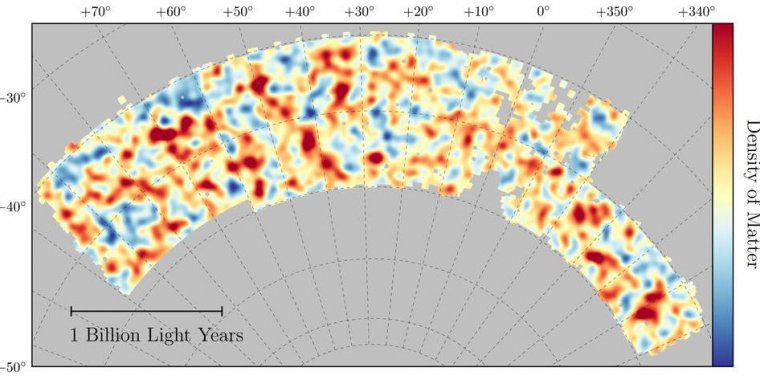| News / Science News |
New Clues to Universe's Structure Revealed
What is our universe made of, and has its composition changed over time? Scientists have new insights about these fundamental questions, thanks to an international collaboration of more than 400 scientists called the Dark Energy Survey (DES).

Map of dark matter made from gravitational lensing measurements of 26 million galaxies in the Dark Energy Survey. The map covers about 1/30th of the entire sky and spans several billion light-years in extent. Red regions have more dark matter than average, blue regions less dark matter. ![]()
Leading models of the universe suggest it is mostly composed of entities we cannot see: dark matter and dark energy. Dark matter acts like invisible glue, holding galaxies and galaxy clusters together gravitationally, while dark energy is thought to be responsible for the accelerated expansion of the universe.
Some of our best predictions for how much dark matter and dark energy are in the universe come from the European Space Agency's Planck satellite, which looks at the light from about 400,000 years after the Big Bang.
Now, the Dark Energy Survey has examined the composition of the recent universe. Remarkably, the new results are close to forecasts made from Planck measurements of the distant past, allowing scientists to understand more about how the universe has evolved over approximately 14 billion years.
Scientists find that about 70 percent of the energy in the universe is contained in dark energy. About 25 percent is composed of the mysterious dark matter, with normal matter making up the remainder. All of this agrees with precise measurements made to date. So far, DES has found no evidence that the amount of dark energy has changed over time -- a finding that is consistent with Albert Einstein's idea of a "cosmological constant."
The results are especially important to the scientific community because they mark the first time that observations from the more recent universe -- the "adult" universe -- by a technique called gravitational lensing and galaxy clustering, have yielded results as precise as those from the cosmic microwave background radiation -- light from the "infant" universe.
To measure dark matter, scientists first created maps of galaxy positions. Then, they precisely measured the shapes of 26 million galaxies to directly map patterns of dark matter over billions of light years, using gravitational lensing and galaxy clustering.
The DES team developed new ways to detect the tiny lensing distortions of galaxy images. In the process, they created the largest guide to spotting dark matter in the cosmos ever drawn. The new dark matter map is 10 times the size of the one DES released in 2015 and continues to grow. (NASA)
YOU MAY ALSO LIKE

